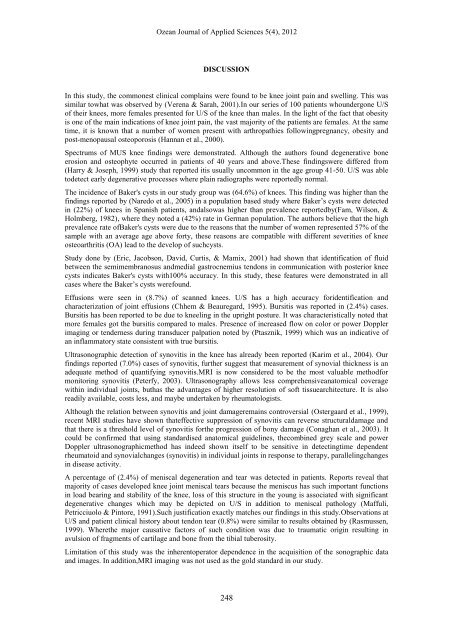ultrasound findings of the knee joint at khartoum teaching hospital ...
ultrasound findings of the knee joint at khartoum teaching hospital ...
ultrasound findings of the knee joint at khartoum teaching hospital ...
You also want an ePaper? Increase the reach of your titles
YUMPU automatically turns print PDFs into web optimized ePapers that Google loves.
Ozean Journal <strong>of</strong> Applied Sciences 5(4), 2012<br />
DISCUSSION<br />
In this study, <strong>the</strong> commonest clinical complains were found to be <strong>knee</strong> <strong>joint</strong> pain and swelling. This was<br />
similar towh<strong>at</strong> was observed by (Verena & Sarah, 2001).In our series <strong>of</strong> 100 p<strong>at</strong>ients whoundergone U/S<br />
<strong>of</strong> <strong>the</strong>ir <strong>knee</strong>s, more females presented for U/S <strong>of</strong> <strong>the</strong> <strong>knee</strong> than males. In <strong>the</strong> light <strong>of</strong> <strong>the</strong> fact th<strong>at</strong> obesity<br />
is one <strong>of</strong> <strong>the</strong> main indic<strong>at</strong>ions <strong>of</strong> <strong>knee</strong> <strong>joint</strong> pain, <strong>the</strong> vast majority <strong>of</strong> <strong>the</strong> p<strong>at</strong>ients are females. At <strong>the</strong> same<br />
time, it is known th<strong>at</strong> a number <strong>of</strong> women present with arthrop<strong>at</strong>hies followingpregnancy, obesity and<br />
post-menopausal osteoporosis (Hannan et al., 2000).<br />
Spectrums <strong>of</strong> MUS <strong>knee</strong> <strong>findings</strong> were demonstr<strong>at</strong>ed. Although <strong>the</strong> authors found degener<strong>at</strong>ive bone<br />
erosion and osteophyte occurred in p<strong>at</strong>ients <strong>of</strong> 40 years and above.These <strong>findings</strong>were differed from<br />
(Harry & Joseph, 1999) study th<strong>at</strong> reported itis usually uncommon in <strong>the</strong> age group 41-50. U/S was able<br />
todetect early degener<strong>at</strong>ive processes where plain radiographs were reportedly normal.<br />
The incidence <strong>of</strong> Baker's cysts in our study group was (64.6%) <strong>of</strong> <strong>knee</strong>s. This finding was higher than <strong>the</strong><br />
<strong>findings</strong> reported by (Naredo et al., 2005) in a popul<strong>at</strong>ion based study where Baker’s cysts were detected<br />
in (22%) <strong>of</strong> <strong>knee</strong>s in Spanish p<strong>at</strong>ients, andalsowas higher than prevalence reportedby(Fam, Wilson, &<br />
Holmberg, 1982), where <strong>the</strong>y noted a (42%) r<strong>at</strong>e in German popul<strong>at</strong>ion. The authors believe th<strong>at</strong> <strong>the</strong> high<br />
prevalence r<strong>at</strong>e <strong>of</strong>Baker's cysts were due to <strong>the</strong> reasons th<strong>at</strong> <strong>the</strong> number <strong>of</strong> women represented 57% <strong>of</strong> <strong>the</strong><br />
sample with an average age above forty, <strong>the</strong>se reasons are comp<strong>at</strong>ible with different severities <strong>of</strong> <strong>knee</strong><br />
osteoarthritis (OA) lead to <strong>the</strong> develop <strong>of</strong> suchcysts.<br />
Study done by (Eric, Jacobson, David, Curtis, & Mamix, 2001) had shown th<strong>at</strong> identific<strong>at</strong>ion <strong>of</strong> fluid<br />
between <strong>the</strong> semimembranosus andmedial gastrocnemius tendons in communic<strong>at</strong>ion with posterior <strong>knee</strong><br />
cysts indic<strong>at</strong>es Baker's cysts with100% accuracy. In this study, <strong>the</strong>se fe<strong>at</strong>ures were demonstr<strong>at</strong>ed in all<br />
cases where <strong>the</strong> Baker’s cysts werefound.<br />
Effusions were seen in (8.7%) <strong>of</strong> scanned <strong>knee</strong>s. U/S has a high accuracy foridentific<strong>at</strong>ion and<br />
characteriz<strong>at</strong>ion <strong>of</strong> <strong>joint</strong> effusions (Chhem & Beauregard, 1995). Bursitis was reported in (2.4%) cases.<br />
Bursitis has been reported to be due to <strong>knee</strong>ling in <strong>the</strong> upright posture. It was characteristically noted th<strong>at</strong><br />
more females got <strong>the</strong> bursitis compared to males. Presence <strong>of</strong> increased flow on color or power Doppler<br />
imaging or tenderness during transducer palp<strong>at</strong>ion noted by (Ptasznik, 1999) which was an indic<strong>at</strong>ive <strong>of</strong><br />
an inflamm<strong>at</strong>ory st<strong>at</strong>e consistent with true bursitis.<br />
Ultrasonographic detection <strong>of</strong> synovitis in <strong>the</strong> <strong>knee</strong> has already been reported (Karim et al., 2004). Our<br />
<strong>findings</strong> reported (7.0%) cases <strong>of</strong> synovitis, fur<strong>the</strong>r suggest th<strong>at</strong> measurement <strong>of</strong> synovial thickness is an<br />
adequ<strong>at</strong>e method <strong>of</strong> quantifying synovitis.MRI is now considered to be <strong>the</strong> most valuable methodfor<br />
monitoring synovitis (Peterfy, 2003). Ultrasonography allows less comprehensivean<strong>at</strong>omical coverage<br />
within individual <strong>joint</strong>s, buthas <strong>the</strong> advantages <strong>of</strong> higher resolution <strong>of</strong> s<strong>of</strong>t tissuearchitecture. It is also<br />
readily available, costs less, and maybe undertaken by rheum<strong>at</strong>ologists.<br />
Although <strong>the</strong> rel<strong>at</strong>ion between synovitis and <strong>joint</strong> damageremains controversial (Ostergaard et al., 1999),<br />
recent MRI studies have shown th<strong>at</strong>effective suppression <strong>of</strong> synovitis can reverse structuraldamage and<br />
th<strong>at</strong> <strong>the</strong>re is a threshold level <strong>of</strong> synovitis for<strong>the</strong> progression <strong>of</strong> bony damage (Conaghan et al., 2003). It<br />
could be confirmed th<strong>at</strong> using standardised an<strong>at</strong>omical guidelines, <strong>the</strong>combined grey scale and power<br />
Doppler ultrasonographicmethod has indeed shown itself to be sensitive in detectingtime dependent<br />
rheum<strong>at</strong>oid and synovialchanges (synovitis) in individual <strong>joint</strong>s in response to <strong>the</strong>rapy, parallelingchanges<br />
in disease activity.<br />
A percentage <strong>of</strong> (2.4%) <strong>of</strong> meniscal degener<strong>at</strong>ion and tear was detected in p<strong>at</strong>ients. Reports reveal th<strong>at</strong><br />
majority <strong>of</strong> cases developed <strong>knee</strong> <strong>joint</strong> meniscal tears because <strong>the</strong> meniscus has such important functions<br />
in load bearing and stability <strong>of</strong> <strong>the</strong> <strong>knee</strong>, loss <strong>of</strong> this structure in <strong>the</strong> young is associ<strong>at</strong>ed with significant<br />
degener<strong>at</strong>ive changes which may be depicted on U/S in addition to meniscal p<strong>at</strong>hology (Maffuli,<br />
Petricciuolo & Pintore, 1991).Such justific<strong>at</strong>ion exactly m<strong>at</strong>ches our <strong>findings</strong> in this study.Observ<strong>at</strong>ions <strong>at</strong><br />
U/S and p<strong>at</strong>ient clinical history about tendon tear (0.8%) were similar to results obtained by (Rasmussen,<br />
1999). Where<strong>the</strong> major caus<strong>at</strong>ive factors <strong>of</strong> such condition was due to traum<strong>at</strong>ic origin resulting in<br />
avulsion <strong>of</strong> fragments <strong>of</strong> cartilage and bone from <strong>the</strong> tibial tuberosity.<br />
Limit<strong>at</strong>ion <strong>of</strong> this study was <strong>the</strong> inherentoper<strong>at</strong>or dependence in <strong>the</strong> acquisition <strong>of</strong> <strong>the</strong> sonographic d<strong>at</strong>a<br />
and images. In addition,MRI imaging was not used as <strong>the</strong> gold standard in our study.<br />
248

















